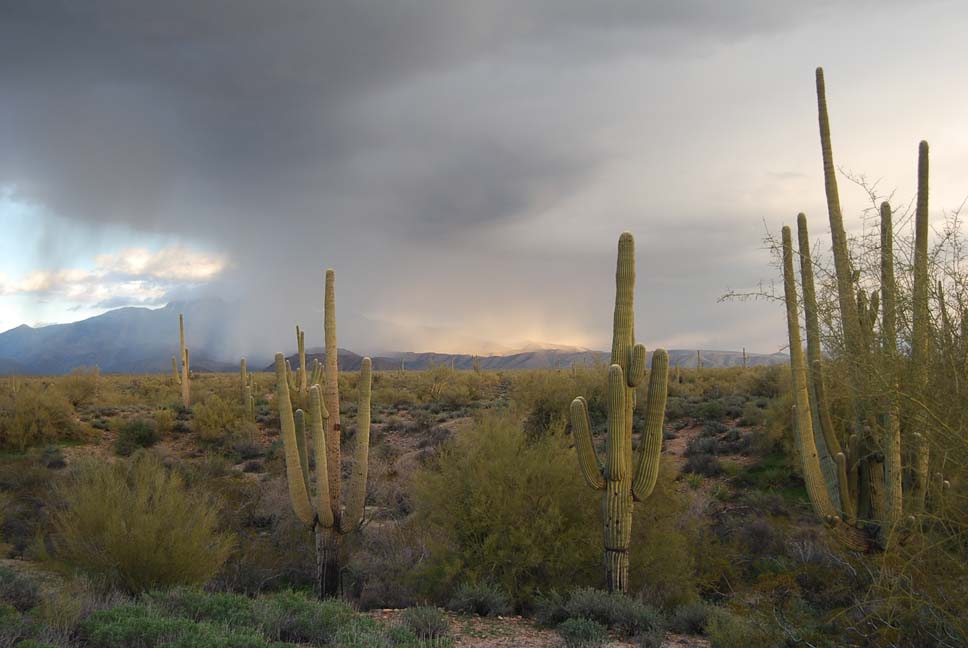– a special report for Florida Wildflowers Pages

Saguaro cacti near Phoenix save up water as storm passes over the desert Photos by the author
as rain slackens thirst; Phoenix area will blossom
By Michael Abrams
Copyrighted
•See companion story on the Grand Canyon
Phoenix, Arizona - Some people in this vast desert metroplex of Phoenix were excited early this year, but not about the million visitors and the commercial boost from the Super Bowl.
By the time we got to Phoenix it was raining.
It's the simple fact that it rained in late January. Rain, glorious rain. People dusted off their umbrellas and waded through a downpour that drenched the streets of Phoenix, made gullies in the parched Sonoran desert and fed the saguaro cactus. That's the cactus with the upraised, prayerful arms.
The desert, of which Phoenix takes a small piece, reaches from California to western Arizona and down into the baja and Mexico. There is nothing in Florida that resembles this desert, where rainfall is less than 10 inches a year and daytime summer temperatures soar beyond 100 degrees Fahrenheit.
It's a land of a million
cacti,
rattlesnakes, gila monsters, arroyos, rocky chocolate hills, scruffy
vegetation, the setting sun tinting the bluffs pink and orange,
the freshly snow-clad mountains as a backdrop.
"We've had three or four good rains since December," says John Sallot, who finds ways to draw about 320,000 visitors a year to the Desert Botanical Garden, a jewel in the conservation movement here. |
 Bee probes red fairy duster plant at botanical garden |
| "Everyone is excited about
the Super Bowl but we're thrilled that it
rained last weekend," says the marketing manager. The desert, of
which Phoenix takes a small piece, reaches from
California to western Arizona and down into the baja and Mexico. Most people have read about the drought which has ravaged nature in this part of the world. But the plants of the desert have survived. Busloads of school kids chug to the Garden which offers a sample curriculum that fits perfectly into state-mandated course requirements. The kids learn about the value of preserving the land, the relationship between plants and animals, some basics. The desert is a lesson in economy, in clinging to less, a metaphor for what could happen to the world. Native Americans knew where to find water to survive. It's not as easy as it looks to get water out of a cactus, says Don Brickley, a former industrial engineer, now 81, who is a veteran docent there and one of 500 volunteers. It would take a lot of cutting and a lot of squeezing - you don't do it like John Wayne did in the movies – cut and sip. |
 Don Brickley holds woody trunk of the saguaro cactus |
| Brickley says the
creosotebush,
which when small looks to one visitor
like a blueberry bush, leaves a ring of growth of new plants and one
particular ring of these plants in California has been determined to be
11,000 years old. Native Americans brewed a medicinal drink from the
leaves of this plant. Those who might order a margarita at a swumpy bar like Sugar Daddy's (author's term for "southwestern upwardly mobile people like you") with its searchlights blazing, should know this drink comes from the agave whose sap the Indians found intoxicating and the Mexicans distilled into tequila. The garden has 169 rare and endangered species, some from deserts in other countries. Its herbarium has 51,000 specimens. Experts have called the Sonoran desert the most biodiverse region on earth for plants and animals says Sallot. The plants and animals have adapted. Some of the trees have green bark, for instance, where chlorophyll in the bark takes over in producing food when the leaves are gone. Small leaves, green bark are adaptations toward living in the desert. How many people know that the cactus has a woody inside and is used by woodpeckers to make nests? Then other birds come, cushion the holes with grass or twigs, and use them again. The garden was founded in 1939 by a group of people alarmed at the rapid development of the desert – not only homes but cotton fields and orange groves, said Mallot. At the time only 50,000 people lived in Phoenix. Now it is the 13th largest Metropolitan Statistical Area in the country with 4 million people. |
 Flowers of aloe brighten the garden |
| Visitors need to open two
separate maps to find streets in Phoenix.
Development will not cease as newcomers retire here from the the
Midwest and northeast, this land where snow is rare and the weather is
right. "The goal of the founders of the garden was to set aside a piece of the desert for future generations," said Sallot. The garden has been fortunate to have generous benefactors. A $17 million campaign in the 90s resulted in a research and education complex. A new campaign of $16.3 million will result in renovated exhibits such as a cactus and succulent gallery. Audio tours will be offered. The visits of 10,000 students a year will be free of charge, to add to the 40,000 students who already come. |
 Emu-bush is native to Australia |
The garden boasts a 400 seat reception hall and gallery, and indoor and outdoor classroom space. It has five thematic trails including one that covers topics like water and energy conservation.
Research scientists at the gardens have benefited Florida. Fairchild Garden in Miami sent cuttings of rare and endangered plants before some recent hurricanes in the 1990s. The salt water intrusion from hurricanes killed the plants in South Florida, and Fairchild was able to reproduce the plants with what had been saved in Phoenix.
With the recent rains in the area, says Sallot, the hills will be filled with wildflowers in April.
